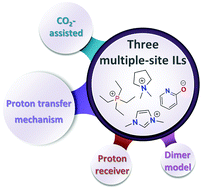Multi-molar CO2 capture beyond the direct Lewis acid–base interaction mechanism†
Abstract
Some singly charged ionic liquids (ILs) have been reported to absorb multi-molar CO2. However, the conventional acid(CO2)–base(anion) interaction picture leads to too weak CO2 binding to support the high uptake. Later, a so-called “cation-channel” mechanism assuming the cation-to-anion proton transfer successfully explains the over equimolar CO2 uptake of some phosphonium-based ILs. Here, by employing the density functional theory (DFT) calculations, we extend the proton transfer mechanism to incorporate imidazole- and ammonium-based ILs as well. For imidazole-based ILs, carbene molecules formed after the proton transfer can react strongly with CO2. More importantly, for ammonium-based ILs, the proton transfer process is feasible only with the help of CO2 molecules. Furthermore, compared to the one IL ion pair model, the model consisting of two IL ion pairs can result in stronger CO2 absorption because it can describe the intermolecular hydrogen bonds more appropriately, especially after incorporating CO2 molecules. The relative acidity and basicity of cations and anions in ILs may be crucial for understanding their functionalization as ILs.



 Please wait while we load your content...
Please wait while we load your content...